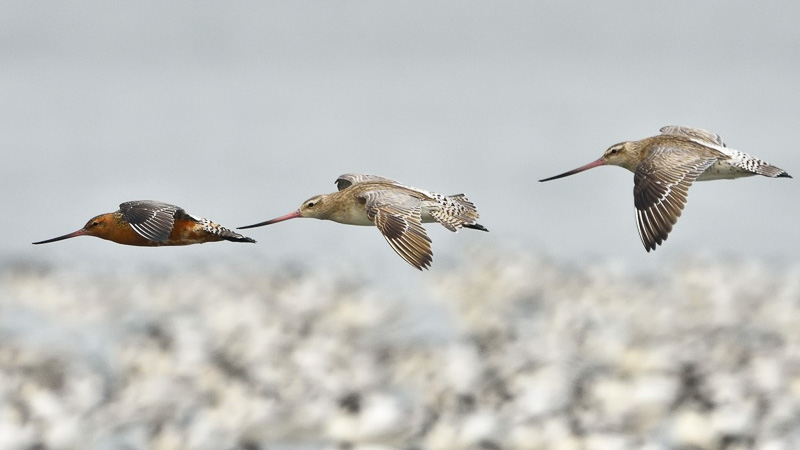Bar-tailed Godwit Limosa lapponica 斑尾塍鷸
Category I. Uncommon passage migrant and rare winter visitor to intertidal areas of Deep Bay.
IDENTIFICATION

Mar. 2016, James Kwok. Non-breeding plumage.
37-39 cm. Female larger and longer-billed than male. Larger than the migrant taxon of Black-tailed Godwit L. limosa melanuroides but approximately same size or slightly smaller than the wintering taxon L. l. bohaii. Bill obviously if slightly upturned (less obvious on females). Birds in non-breeding plumage have dark centred and pale fringed upperpart feathers (in contrast to plain upperparts of Black-tailed Godwit) and extensive pink at base of bill. Juveniles have buff notches to edges of tertials and scapulars.

Apr. 2018, Kinni Ho. Adult male, breeding plumage.
Adult male in breeding plumage has brick red underparts while females are paler. Bill is darker than non-breeding plumage and scapulars are blackish and orange.

Apr. 2018, Kinni Ho.
In flight legs project moderately beyond densely barred tail, white extends up back to a point and there is a very narrow wing bar largely formed by the tips of greater primary coverts which are otherwise plain and dark.
L. l. baueri averages larger and has darker rump, uppertail coverts, underwing and axillaries than other subspecies.
VOCALISATIONS
The typical call note is a double note, slightly plaintive in tone.
DISTRIBUTION & HABITAT PREFERENCE
Bar-tailed Godwit is very rare away from the intertidal mudflats of Deep Bay and adjacent roosting areas at Mai Po NR. There are only six records of grounded birds away from here: six on 28 September 1970 at Sha Tau Kok, four on 23 September 1975 with one remaining on 15 October at Tai Po, two at the former airport at Kai Tak on 7th and 14 April 1978, one at Shuen Wan on 24 March 1993, seven at Starling Inlet on 6 September 1997 and one at Long Valley on 5 October 2011. There are no records from commercial fish ponds.
There are also records of up to 60 birds on migration over the sea near Po Toi from 26 March to 30 April and off Cape D’Aguilar during tropical storms in autumn.
OCCURRENCE
Bar-tailed Godwit is an uncommon passage migrant with very small numbers occasionally occurring in winter.
Wintering birds appear to remain into March, while the first spring migrants are noted during the middle of the month. Main spring passage occurs from the final week of March to the third week of April, with the highest numbers occurring during the second week of April (Figure 1). Peak counts are generally 30 or fewer, though occasionally much higher counts are made, presumably of birds forced west from their usual migration route by adverse winds. Thus 235 were recorded on 11 April 2015, 155 on 12 April 2013 and 105 in April 2007 and 2009. Up to four birds have been noted in June and July.
In most years autumn migrants are noted from around the middle of August. The main autumn passage period extends from the second week of September to the first week of October. The highest count is 400 on 14 September 1981, the next highest being 160 on 20 September 1987; in contrast, the highest autumn count this century, however, is only 61. Juveniles predominate in autumn and have been reported from 24 August to 26 October. It seems that after the end of November only wintering birds, usually numbering five or fewer, remain.
The first record of Bar-tailed Godwit was that of Walker (1958), who had one at Mai Po on 15 May 1957. Macfarlane and Macdonald (1966) noted that there had been regular records of up to twelve birds from 30 March to 15 May and from 7 September to 22 November.
BEHAVIOUR, FORAGING & DIET
Foraging action differs from Black-tailed Godwit in that probes into mud are more vertical and prolonged, and consequently movement across the mudflat is slower.
RANGE & SYSTEMATICS
Breeding areas are scattered across near the coast north of the Arctic Circle from northern Scandinavia as far as the Sea of Okhotsk; winters coastally through much of Africa, southwest Asia, the Indian subcontinent, southeast Asia, south China and Australasia (McCaffery and Gill 2020). In China a migrant mainly through the east of the country; small numbers spend the summer on Yellow Sea coast and winter along the south coast (Liu and Chen 2020).
Four subspecies are recognised of which the two utilising the East Asia-Australasian flyway, L. l. menzbieri and L. l. baueri, breeding in northeast Siberia and Alaska, are presumed to occur in HK. Liu and Chen (2020) state that juvenile, not adult, L. l. baueri pass through in autumn, while L. l. menzbieri is a migrant and winter visitor. The remaining two subspecies breed to the west and winter in Africa, India and southwest Asia.
CONSERVATION STATUS
IUCN: Near-threatened. Two subspecies, menzbieri and baueri, use the East Asian-Australasian Flyway and are both undergoing extremely rapid declines, probably owing to severe habitat loss in the Yellow Sea.
Figure 1.

Macfarlane, A. M. and A. D. Macdonald, revised by Caunter, J. R. L. and A. M. Macfarlane (1966). An Annotated Check-list of the Birds of Hong Kong. Hong Kong Bird Watching Society, Hong Kong.
McCaffery, B. J. and R. E. Gill (2020). Bar-tailed Godwit (Limosa lapponica), version 1.0. In Birds of the World (S. M. Billerman, Editor). Cornell Lab of Ornithology, Ithaca, NY, USA. https://doi.org/10.2173/bow.batgod.01
Walker, F. J. (1958). Field observations on birds in the Colony of Hong Kong. Hong Kong Bird Watching Society (duplicated).
Liu, Y and Y. H. Chen (eds) (2020). The CNG Field Guide to the Birds of China (in Chinese). Hunan Science and Technology Publication House, Changsha.

